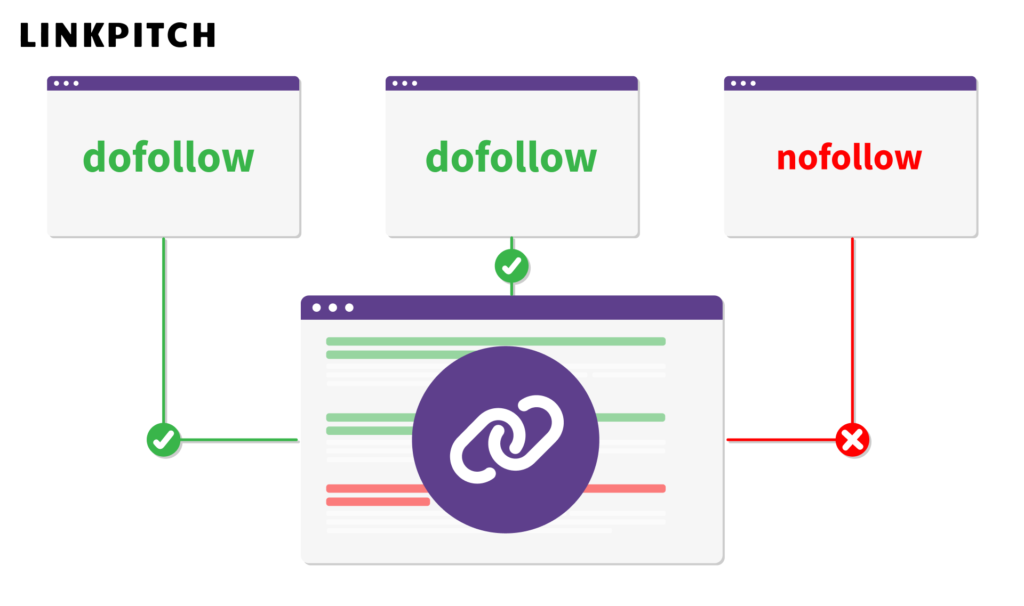Google continually analyzes and gathers information from the links between websites. When a website adds a link to another site, certain elements can be used by website owners and webmasters to give Google more information about the link.
Nofollow and dofollow are two categories into which sites can classify any outgoing links. Which category a link goes into depends on the information that websites want to share with Google about the outgoing link and the relationship they have with the site that they’re linking to.
Let’s have a look at the links on this excerpt from a monday.com article about project management:
There are two links in this part of the article. And, they look pretty similar, right? Except one of them is a dofollow link, while the other one is a nofollow link. What does this mean, and which is which?
In this article, I’ll walk you through the basics of what constitutes a follow or nofollow link, the SEO implications of both types of links, and how to tell them apart.
Let’s start with nofollow links.
What are Nofollow Links?
Google is always looking for new content on the web that is relevant to their users.
To do this, it sends out robots that follow the links within a group of pages and then creates an index with the information they retrieve.
Nofollow links have a rel=”nofollow” tag within the code that tells Google bots not to follow these links. Additionally, the flag tells Google not to associate the linked page to the page the link is on. This is what the code for the second link from our previous example looks like:
The second link on the example has the rel=”nofollow” tag and is therefore a nofollow link.
The nofollow attribute was first introduced by Google in 2005 as a tool to help fight comment spam. Before the ability to flag a link as nofollow, some people used the comments section of other websites to post a link to their own site and try to get link juice from them.
What are Dofollow Links?
Dofollow links, on the other hand, don’t have the rel=”nofollow” tag. This is what the code for the first link on our example looks like:
As you can see, there is no rel=”nofollow” tag, which automatically makes the link a dofollow link. All links are dofollow by default, and they’ll be dofollow unless the nofollow tag is added.
When a Google bot crawls a page that has a dofollow link on it, it will follow the link and associate the page that has been linked to with the page the link was found on.
Now that you know the difference between a nofollow link and a dofollow link, let’s see what your backlink falling into either category actually means.
Nofollow vs. Dofollow: SEO Implications
If you’ve tried to improve the rankings of pages on your site by getting more quality backlinks, you might’ve heard that nofollow backlinks won’t benefit you.
Let’s see if this is true.
When a website adds a dofollow link to another site, it tells Google that the other site is trustworthy and that they want to be associated with that site. However, a site that adds a nofollow link to another one is telling Google not to associate them with that site.
Therefore, dofollow links pass link authority onto the page that is being linked to, while nofollow links do not (at least according to official statements from Google). This means that dofollow links can directly impact a website’s rankings because they transfer link juice.

So, does this mean nofollow links are worthless?
No. Even when nofollow links don’t officially pass any link juice, they are still very useful (and even necessary).
Here are a few reasons why this is true:
1. They are essential for a natural backlink profile.
There are two main ways your site can get more backlinks: either through link building strategies or when other sites link to you naturally. But, how other sites link to you is not something you can control. And this includes whether the links are dofollow or nofollow. So, if your site only has dofollow backlinks, that could potentially raise some red flags for Google’s bots.
2. They still drive traffic.
Nofollow links can still be clicked on by any person that comes across the link. So, if you get a nofollow link from a site with a lot of visitors, chances are some of those visitors will click on the link and get to your site anyway, whether the link is dofollow or not. Getting nofollow links from other sites can help your site increase its traffic and even help you increase brand awareness.
Which brings me to my next point.
3. They can generate additional, dofollow links.
Increasing brand awareness can lead to more people writing about your product or service, which can lead to them linking to you naturally. And some of these links will probably be dofollow.
4. Google has modified the nofollow attribute’s initial purpose.
As we saw before, the nofollow category was introduced by Google to combat spammy links in comments.
The use of the nofollow attribute has been used for different purposes by websites ever since (e.g. to flag sponsored or paid links). But Google themselves have recently stated that the nofollow attribute is now not a directive, but rather just a hint, which has opened up some space for interpretation: some nofollow links could in fact be considered deserving of link authority being passed on.
Much like their ranking algorithm, the way each individual nofollow link is treated by Google remains a secret. Several experiments have been made in an attempt to figure out the effect that nofollow links have in terms of rankings.
This study by Ahrefs, for example, shows that the correlation between the ranking of a page and total number of dofollow backlinks is a bit weaker than the correlation between page ranking and total number of backlinks (including nofollow links). This could mean that Google does take some nofollow links into account for ranking purposes.
Be it as it may, links that are relevant, authoritative, and high-quality will still be beneficial for a site, whether they’re dofollow or not, and even if they don’t transfer link juice or impact rankings directly.
Nofollow vs. Dofollow: How to Identify Them
As we saw previously, whether a link is nofollow or dofollow can’t seem to be determined at first glance. The two main ways you can tell whether a link is followed or not are:
1. Look at the page’s source code.
While looking at any page, you can look at its source code by right-clicking anywhere on the page and then clicking on “View source code.” Alternatively, you can use the Ctrl + U command).
Then, you can use the Ctrl + F command to search for the link’s anchor text or URL on the source code.
If the code includes the rel=”nofollow” tag, it’s a nofollow link. If it doesn’t, then your link is dofollow!
2. Use a browser extension.
There are several browser extensions out there that can tell you whether a link is dofollow or not or highlight any nofollow links on any given page.
In our monday.com example, I used the NoFollow extension on Chrome to highlight the nofollow links on that page. The other links on the paragraph are dofollow, and therefore have not been highlighted by the extension.
Nofollow and Dofollow Links and Your SEO Strategy
In this article, I’ve shown you the differences between a dofollow and a nofollow link, some tricks to help you identify each of them, and how each type of link can impact your site’s overall SEO.
The information I’ve shared with you can give you a better understanding of the links your site is getting and how your site benefits from them.
However, remember that the distinction between dofollow and nofollow links is far from being a ‘good links’ vs. ‘bad links’ kind of distinction. Rather than worrying too much about whether the links you are getting are dofollow or not, you can shift your SEO strategy’s focus to building relevant, authoritative, and high-quality links to your site. This approach should result in a higher impact on your site.
Still have questions? Share them in the comments section below!

